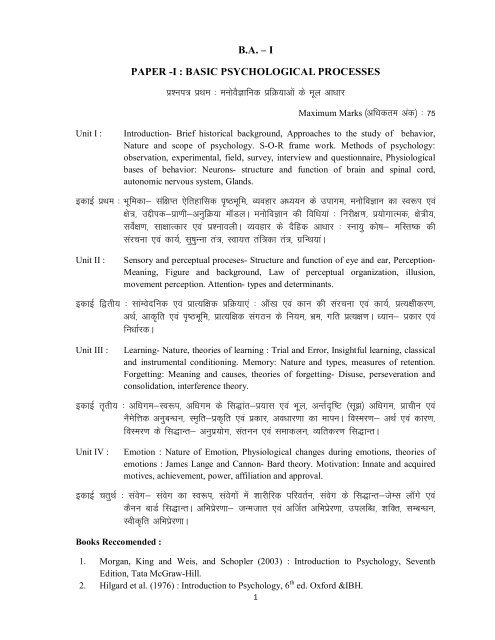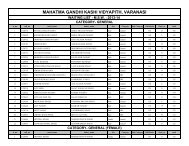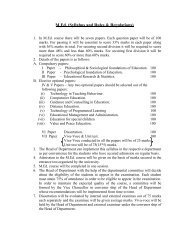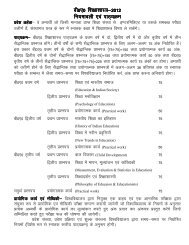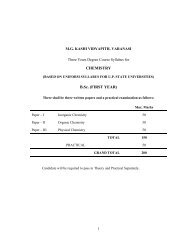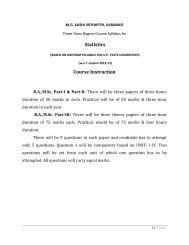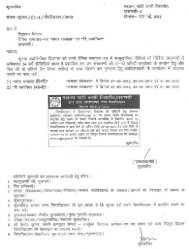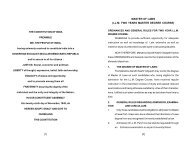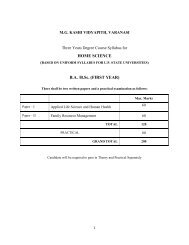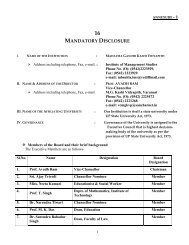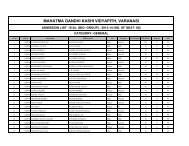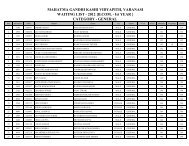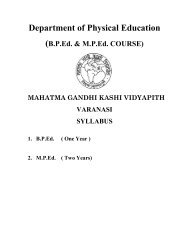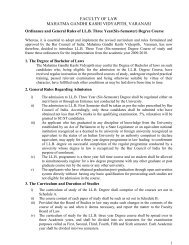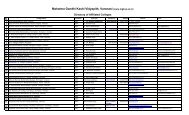B.A. – I PAPER -I : BASIC PSYCHOLOGICAL PROCESSES iz” ui ...
B.A. – I PAPER -I : BASIC PSYCHOLOGICAL PROCESSES iz” ui ...
B.A. – I PAPER -I : BASIC PSYCHOLOGICAL PROCESSES iz” ui ...
Create successful ePaper yourself
Turn your PDF publications into a flip-book with our unique Google optimized e-Paper software.
B.A. <strong>–</strong> I<br />
<strong>PAPER</strong> -I : <strong>BASIC</strong> <strong>PSYCHOLOGICAL</strong> <strong>PROCESSES</strong><br />
<strong>iz”</strong><strong>ui</strong>= izFke % euksoSKkfud izfØ;kvksa ds ewy vk/kkj<br />
Maximum Marks ¼vf/kdre vad½ % 75<br />
Unit I : Introduction- Brief historical background, Approaches to the study of behavior,<br />
Nature and scope of psychology. S-O-R frame work. Methods of psychology:<br />
observation, experimental, field, survey, interview and questionnaire, Physiological<br />
bases of behavior: Neurons- structure and function of brain and spinal cord,<br />
autonomic nervous system, Glands.<br />
bdkbZ izFke % Hkwfedk& laf{kIr ,sfrgkfld i`’BHkwfe] O;ogkj v/;;u ds mikxe] euksfoKku dk Lo:Ik ,oa<br />
{ks=] míhid&izk.kh&vuqfØ;k ekWMyA euksfoKku dh fof/k;ka % fujh{k.k] iz;ksxkRed] {ks=h;]<br />
losZ{k.k] lk{kkRdkj ,oa <strong>iz”</strong>ukoyhA O;ogkj ds nSfgd vk/kkj % Luk;q dks’k& efLr’d dh<br />
lajpuk ,oa dk;Z] lq’kqUuk ra=] Lok;Ùk raf=dk ra=] xzfUFk;kaA<br />
Unit II : Sensory and perceptual proceses- Structure and function of eye and ear, Perception-<br />
Meaning, Figure and background, Law of perceptual organization, illusion,<br />
movement perception. Attention- types and determinants.<br />
bdkbZ f}rh; % lkaEosnfud ,oa izkR;f{kd izfØ;k,a % vk¡[k ,oa dku dh lajpuk ,oa dk;Z] izR;{khdj.k]<br />
vFkZ] vkd`fr ,oa i`’BHkwfe] izkR;f{kd laxBu ds fu;e] Hkze] xfr izR;{k.kA /;ku& izdkj ,oa<br />
fu/kkZjdA<br />
Unit III : Learning- Nature, theories of learning : Trial and Error, Insightful learning, classical<br />
and instrumental conditioning. Memory: Nature and types, measures of retention.<br />
Forgetting: Meaning and causes, theories of forgetting- Disuse, perseveration and<br />
consolidation, interference theory.<br />
bdkbZ r`rh; % vf/kxe&Lo:i] vf/kxe ds fl)kar&iz;kl ,oa Hkwy] vUrZn`f’V ¼lw>½ vf/kxe] izkphu ,oa<br />
uSesfÙkd vuqcU/ku] Le`fr&izd`fr ,oa izdkj] vo/kkj.kk dk ekiuA foLej.k& vFkZ ,oa dkj.k]<br />
foLej.k ds fl)kUr& vuqiz;ksx] laruu ,oa lekdyu] O;frdj.k fl)kUrA<br />
Unit IV : Emotion : Nature of Emotion, Physiological changes during emotions, theories of<br />
emotions : James Lange and Cannon- Bard theory. Motivation: Innate and acq<strong>ui</strong>red<br />
motives, achievement, power, affiliation and approval.<br />
bdkbZ prqFkZ % laosx& laosx dk Lo:i] laosxksa esa “kkjhfjd ifjorZu] laosx ds fl)kUr&tsEl yk¡xs ,oa<br />
dSuu ckMZ fl)kUrA vfHkizsj.kk& tUetkr ,oa vftZr vfHkizsj.kk] miyfC/k] “kfDr] lEcU/ku]<br />
Lohd`fr vfHkizsj.kkA<br />
Books Reccomended :<br />
1. Morgan, King and Weis, and Schopler (2003) : Introduction to Psychology, Seventh<br />
Edition, Tata McGraw-Hill.<br />
2. Hilgard et al. (1976) : Introduction to Psychology, 6<br />
1<br />
th ed. Oxford &IBH.
3. Bourne, L.E. et al. psychology, Halt, N.Y.<br />
4. Rathus, S.W. : Psychology, Halt, N.Y.<br />
5. Green, H. (1988) 7 th Indian addition.<br />
6. N.L. Munn (2000) : Introduction to Psychology.<br />
7. v:.k dqekj flag ¼2008½ % vk/kqfud lkekU; euksfoKku] eksrhyky cukjlh nkl] okjk.klh] 2008<br />
8. vtheqjZgeku ¼1998½ % lkekU; euksfoKkuA<br />
9. vkj-,u- flag ¼2005½ % vk/kqfud lkekU; euksfoKku] fouksn iqLrd eafnj] vkxjkA<br />
B.A. <strong>–</strong> I<br />
<strong>PAPER</strong> -II : HUMAN DEVELOPMENT<br />
Ikz”<strong>ui</strong>= f}rh; % ekuo fodkl<br />
2<br />
Maximum Marks ¼vf/kdre vad½ % 75<br />
Unit I : Human development : Nature and Scope. Principal of development, laws of<br />
development, stages of development, methods of studying development-longitudinal<br />
and cross-sectional, Dynamics of human development- Role of maturation and<br />
learning. Heredity and environment, Imitation and identification.<br />
bdkbZ izFke % ekuo fodkl % izd`fr] {ks=A fodkl dk fl)kUr] fodkl ds fu;e] fodkl dh voLFkk,a]<br />
fodkl v/;;u dh fof/k;k¡&vuqnS/;Z ,oa izfrfu/;kRed] ekuo fodkl dh xR;kRedrk&<br />
ifjiDork vkSj vf/kxe dh Hkwfedk] vkuqoaf”kdrk ,oa Ik;kZoj.k] vuqdj.k ,oa rknkRehdj.kA<br />
Unit II : Physical development <strong>–</strong> Meaning, stages, prenatal and postnatal determinants.<br />
Development of nervous system and motor abilities, Sensory and perceptual<br />
developmental processes, Sensory capacities of infants. Perceptual development-<br />
dimentions and determinants.<br />
bdkbZ f}rh; % “kkjhfjd fodkl % vFkZ] fLFkfr;k¡] xHkZdkyhu ,oa tUeksijkUr] “kkjhfjd fodkl ds<br />
fu/kkZjdA Luk;q laLFkku vkSj xR;kRed ;ksX;rkvksa dk fodkl] lkaosnfud ,oa izkR;f{kd<br />
fodkl& izfØ;k,a] f”k”kq dh lkaosnfud vfHk{kerk,aA izkR;f{kd fodkl& vk;ke ,oa<br />
fu/kkZjdA<br />
Unit III : Development of cognition and understanding: meaning and theory of cognitive<br />
development, development of understanding: factors, concept of development and<br />
language development. Social development : Criteria and stages, Concept and<br />
development of emotions, Watson and Bridges theories. Concept and development<br />
of morality, Kohlberg’s theory and determinants.<br />
bdkbZ r`rh; % laKkukRed fodkl ,oa cks/k % laKkukRed fodkl ds vFkZ ,oa fl)kUr] cks/k dk<br />
fodkl&dkjd] laEizR;; ,oa Hkk’kk fodkl] lkekftd fodkl dk lEizR;;&dlkSfV;k ,oa<br />
voLFkk,a] laosx dk lEizR;; vkSj fodkl&okV~lu vkSj fczt ds fl)kUrA uSfrdrk dk<br />
lEizR;; ,oa fodkl] dksgy cxZ dk fl)kUr ,oa fu/kkZjdA
Unit IV : Adolescence : meaning, characteristics, changes and problems. Exceptional children<br />
: meaning and types- mentally retarded, Gifted child, Delinquent child, Backward<br />
child. Aging- meaning, characteristics- personal, social, vocational and family<br />
adjustment, Factors influencing adjustment during aging.<br />
bdkbZ prqFkZ % fd”kksjkokLFkk % vFkZ] fo”ks’krk,a] ifjorZu ,oa leL;k,aA fof”k’V ckyd&vFkZ ,oa izdkj] eUn<br />
cqf) ckyd] izfrHkk”kkyh ckyd] vijk/kh ckyd] fiNM+s ckydA o;cqf)& vFkZ<br />
fo”ks’krk,aⓈfäd] lkekftd]O;olkf;d] ikfjokfjd lek;kstu] vk;q fodkl esa lek;kstu<br />
dks izHkkfor djus okys dkjdA<br />
Books :<br />
1. Baltes & Brim (1980) : Life Span Development and Behaviour.<br />
2. Berk, L.E. (2003) : Child Development, 6 th Edi., Prentice-Hall, India.<br />
3. Hurlock,E.B. (2001) ; Child Development, 6 th Edi. TATA McGrw-Hill.<br />
4. Libert (1980) : Development psychology, Sage.<br />
5. Stott, L.H. (1978) : The Psychology of Human Development.<br />
6. Winder Zanden : Human Development, Alferd Knof, N.Y.<br />
7. Ykky] ts-,u- ¼2000½ % vk/kqfud fodklkRed euksfoKku] fouksn iqLrd eafnj] vkxjkA<br />
8. flag] vkj-,u- ¼2002½ % vk/kqfud fodklkRed euksfoKku] fouksn iqLrd eafnj] vkxjkA<br />
9. flag] jktsUnz izlkn] ftrsUnz mik/;k;] jktsUnz flag ¼2009½ % fodklkRed euksfoKku] eksrhyky cukjlhnkl] okjk.klh<br />
B.A. <strong>–</strong> I<br />
<strong>PAPER</strong> <strong>–</strong>III : Practical<br />
Ikz’<strong>ui</strong>= r`rh; % izk;ksfxd dk;Z<br />
(Any eight of the following 10 practicals)<br />
¼fuEufyf[kr 10 esa ls dksbZ 8 izk;ksfxd dk;Z½<br />
3<br />
Maximum Marks ¼vf/kdre vad½ % 50<br />
1. Span of attention ¼/;ku foLrkj½<br />
2. Negative after image ¼fu’ks/kkRed vuqlaosnuk½<br />
3. Learning curve ( Maze learning) ¼vf/kxe oØ@ Hkwy&HkwyS;k vf/kxe½<br />
4. Bilateral transfer ¼f}ikf”oZd LFkkukUrj.k½<br />
5. Verbal intelligence test ¼”kkfCnd cqf) ijh{k.k½<br />
6. Simple Reaction Time ¼lkekU; izfrfØ;k dky½<br />
7. Introvert -Extrovert Test ¼vUrZeq[krk&cfgZeq[krk ijh{k.k½<br />
8. Measurement of self-esteem of children ¼cPpksa ds vkRe&cks/k dk ekiu½<br />
9. Social/Emotion Maturity test ¼lkekftd@laosxkRed ifjiDork ijh{k.k½<br />
10. Measurement of moral values ¼uSfrd ewY;ksa dk ekiu½
B.A. <strong>–</strong> II<br />
<strong>PAPER</strong> <strong>–</strong>I : Social Psychology<br />
Ikz’<strong>ui</strong>= izFke % lekt euksfoKku<br />
4<br />
Maximum Marks ¼vf/kdre vad½ % 75<br />
Unit-I : Social Psychology : Nature and Scope, Historical background, Theories <strong>–</strong> Role,<br />
Learning and Cognitive. Methods of Study- Experimental, Quasiexperimental,<br />
Field study, Survey, Interview and Cross-Cultural.<br />
bdkbZ izFke % lekt euksfoKku % Lo:i] {ks=] ,frgkfld i`’BHkwfe] fl)kUr& Hkwfedk] vf/kxe ,oa<br />
laKkuA v/;;u dh fof/k;kWa& iz;ksxkRed] vkHkklh iz;ksxkRed] {ks= v/;;u] losZ{k.k]<br />
lk{kkRdkj ,oa vUrZlkaLd`frdA<br />
Unit-II : Social Perception : Meaning and Determinants. Person perception : Impression<br />
formation, Determinants, Causal Attribution theory. Attitude : Meaning,<br />
Components, Characteristics and Measurement- Thusrstone, Likert, Semantic<br />
Differential. Attitude and behaviour, Attitude formation and Change : Persuasion<br />
and resistance to change, Theories-Balance and Cognitive Dissonance.<br />
bdkbZ f}rh; % lkekftd izR;{k.k % vFkZ ,oa fu/kkZjdA O;fä izR;{k.k% Nfo fuekZ.k] fu/kkZjd] xq.kkjksi.k<br />
fufeÙk fl)kUrA vfHko`fÙk % vFkZ] la?kVd ,oa fo”ks’krk,aA ekiu&FkLVZu] fydVZ] “kkfCnd<br />
foHksnuA vfHko`fÙk ,oa O;ogkj] vfHko`fÙk fuekZ.k ,oa ifjorZu% ifjorZu ds izHkko ,oa<br />
izfrjks/k] fl)kUr&larqyu ,oa laKkukRed vlaokfnrkA<br />
Unit-III : Interpersonal Attraction : Meaning, Measurement, Determinants. Social<br />
influence-Conformity, Obedience and Compliance. Aggression and Violence :<br />
Influencing factors. Violence in society; Helping and Prosocial Behaviour.<br />
Meaning, Theories and Determinants.<br />
bdkbZ r`rh; % vUrZoS;fäd vkd’kZ.k % vFkZ] ekiu] fu/kkZjdA lkekftd izHkko”khyrk& vuq:irk]<br />
vkKkdkfjrk ,oa vuqikyuA vkØkedrk ,oa fgalk % izHkkfor djus okys dkjdA lekt esa<br />
fgalk( lg;ksx] lg;ksx ijd ,oa izlkekftd O;ogkj % vFkZ] fl)kUr ,oa fu/kkZjdA<br />
Unit-IV : Social group : Meaning, Types, Characteristics <strong>–</strong> Cohesiveness, Effectiveness.<br />
Group dynamics : Leadership- Meaning, Types, Theories. Intergroup behaviour <strong>–</strong><br />
Prejudice and Discrimination. Intragroup conflicts. Causes and Methods of<br />
resolution.
dkbZ prqFkZ % lkekftd lewg % vFkZ] izdkj] fo”ks’krk,a& lexzrk] izHkko”khyrkA lewg xfrdhA<br />
Recommended Books :<br />
usr`Ro % vFkZ] izdkj] fl)kUrA vUrZlewg O;ogkj& iwokZxzg ,oa foHksnhdj.kA vUrZlewg]<br />
}U}] lek/kku ds dkjd ,oa fof/k;k¡A<br />
1. Byrne-Understanding Human Behviour, Holt.<br />
2. Hilgard, et. al. (1976) : Introduction to Psychology. 6 th Edition, Oxford & IBH.<br />
3. Kay Deux et. al. Social Psychology in the 90’s Saze.<br />
4. Morgan, C.T. , J.D. Weis; and J. Schopler King R.A. (2005) : Introduction to Psychology. 7 th<br />
Edition, Tata Mc Graw-Hill.<br />
5. Ruch : Psychology and Life.<br />
6. Rahman, Azimurr : Samanya Manovigyana<br />
7. Secord and Backman <strong>–</strong> Social Psychology, McGraw Hill.<br />
8- flag] v:.k dqekj ¼2003½ % lkekftd euksfoKku] eksrhyky cukjlh nkl] okjk.klh<br />
9- f=ikBh] ,y-ch- ¼2005½ % vk/kqfud lkekftd euksfoKku] gj izlkn HkkxZo] vkxjk<br />
10- flag] vkj-,u- ¼2005½ % vk/kqfud lkekftd euksfoKku] f}rh; laLdj.k] fouksn iqLrd eafnj] vkxjk<br />
B.A. <strong>–</strong> II<br />
<strong>PAPER</strong> <strong>–</strong> II : Psychopathology<br />
Ikz’<strong>ui</strong>= f}rh; % euksfod`fr foKku<br />
5<br />
Maximum Marks ¼vf/kdre vad½ % 75<br />
Unit-I : Introduction to Psychopathology. Concept of normality and abnormality. View<br />
points about abnormality. Classification of mental disorders <strong>–</strong> DSM IV & ICD-10.<br />
Symptoms and syndromes of mental disorders.<br />
bdkbZ izFke % euksfod`fr foKku dk ifjp;A lkekU;rk&vlkekU;rk dk laizR;;] vlkekU;rk ds<br />
n`f’Vdks.kA O;ogkj fod`fr;ksa dk oxhZdj.k&Mh-,l-,e-&prqFkZ ,oa vkbZ-lh-Mh- 10A<br />
ekufld fod`fr;ksa ds y{k.k ,oa lay{k.kA
Unit-II : Models of psychopathology - Psychodynamic, Behavioral and Cognitive.<br />
Adjustment Mechanisms, Frustration and Defense mechanisms, Conflict. Methods<br />
of psychopathology: Case history, interview and projective techniques.<br />
bdkbZ f}rh; % euksfod`fr foKku ds izfreku& euksxfrdh izfreku] O;ogkjoknh izfreku ,oa laKkukRed<br />
izfrekuA lek;kstu ;qfä;k¡ % dqaBk ,oa euks jpuk,a] vUrZ}UnA euksfod`fr foKku dh<br />
fof/k;ka% O;fä bfrgkl fof/k] lk{kkRdkj fof/k ,oa iz{ksi.k izfof/k;k¡A<br />
Unit-III : Anxiety disorders: Definition, symptoms and etiology, Phobic Disorders- Nature,<br />
symptoms, types and etiology, Obsessive- Compulsive disorder, Psychotic disorders-<br />
Schizophrenia : Nature, symptoms, types and causes, Delusional Disorder: Nature,<br />
symptom, types and etiology, Mood Disorder- Nature and types.<br />
bdkbZ r`rh; % lkekU;hd`r fpUrk fod`fr;k¡ % ifjHkk’kk] y{k.k ,oa dkj.k] nqHkhZrh fpark fod`fr&izd`fr]<br />
y{k.k] izdkj] dkj.k] euksxzfLr ck/;rk fod`frA euksfofPNIrrk fod`fr;k %<br />
euksfonyrk&Lo:i] y{k.k] izdkj ,oa dkj.k] O;keksgh fod`fr& Lo:Ik] y{k.k] izdkj ,oa<br />
dkj.k] euksn”kk fod`fr&Lo:i o izdkjA<br />
Unit-IV : Personality disorders : Psychopatic personality, Alcohol and drug abuse and<br />
dependence. Mental Reatardation : Concept, characteristics, types and causes.<br />
Dissociative disorders- Nature, types, characteristics and etiology. Conversion<br />
disorder : Nature, Symptoms and causes.<br />
bdkbZ prqFkZ % O;fäRo fod`fr;k¡& euksfod`r O;fäRo] e|iku ,oa nzO; O;lu fuHkZjrk] fo”ks’krk,aA<br />
ekufld eUnu& vFkZ] fo”ks’krk,a] izdkj ,oa dkj.k] euksfoPNsnh fod`fr&Lo:i] izdkj ,oa<br />
dkj.k] :ikUrj.k fod`fr& Lo:i] y{k.k ,oa dkj.kA<br />
Recommended Books :<br />
1. Buss, A.H. (1999) Psychopathology N.Y., John Wiley.<br />
2. Coleman ; Abnormal psychology and Modern Life <strong>–</strong> Taraporawala & Sons. Bombay.<br />
3. Shanmugam : Abnormal Psychology, Tara-McGraw Hill, New Delhi.<br />
4. Rosen, E. & Gregory, I : Abnormal Psychology.<br />
5- t;xksiky f=ikBh ,oa foods f=ikBh ¼2001½ % vlkekU; euksfoKku] gj izlkn HkkxZo] vkxjkA<br />
6- ykHk flag ,oa xksfoUn frokjh ¼2002½ % vlkekU; euksfoKku] fouksn iqLrd Hk.Mkj] vkxjkA<br />
7-- flag] v:.k dqekj ¼2002½ % vk/kqfud vlkekU; euksfoKku] eksrh yky cukjlh nkl] okjk.klhA<br />
6
8- eqgEen lqyseku ,oa eqgEen rkSokc ¼2004½ % vlkekU; euksfoKku % fo’k; ,oa O;k[;k] eksrhyky<br />
cukjlhnkl] okjk.klhA<br />
9- Mk- vt; dqekj JhokLro ¼2008½ % euksfod`fr foKku] vxzoky ifCyds”ku] vkxjkA<br />
10- fourh vkuUn ¼2004½ % euksfod`fr foKku] eksrhyky cukjlh nkl] okjk.klhA<br />
11- eqgEen lqyseku ¼2005½ % euksjksx foKku] eksrhyky cukjlhnkl] okjk.klhA<br />
B.A. <strong>–</strong> II<br />
<strong>PAPER</strong> <strong>–</strong> III : Practical<br />
Ikz’<strong>ui</strong>= r`rh; % izk;ksfxd dk;Z<br />
(Any 8 of the following 10 practicals)<br />
¼fuEufyf[kr 10 esa ls dksbZ 8 izk;ksfxd dk;Z½<br />
1. Rumor analysis ¼izokn fo”ys’k.k½<br />
2. Sociometry ¼lektfefr½<br />
3. Measurement of attitude ¼vfHko`fÙk dk ekiu½<br />
4. Measurement of Social conformity ¼lkekftd vuq:irk dk ekiu½<br />
5. Study of caste Prejudice ¼tkfr iwokZxzg dk v/;;u½<br />
6. Measurement of Adjustment ¼lek;kstu dk ekiu½<br />
7. Measurement of Depression ¼volkn dk ekiu½<br />
8. Measurement of Anxiety ¼fpUrk dk ekiu½<br />
9. Measurement of Mental Health ¼ekufld LokLF; dk ekiu½<br />
10. Measurement of Insecurity ¼vlqj{kk dk ekiu½<br />
7<br />
Maximum Marks ¼vf/kdre vad½ % 50
B.A. III<br />
<strong>PAPER</strong> <strong>–</strong>I : Psychological Statistics<br />
Ikz’<strong>ui</strong>= izFke % euksfoKku esa lkaf[;dh<br />
8<br />
Maximum Marks ¼vf/kdre vad½ % 75<br />
Unit <strong>–</strong> I : Nature of Psychological Data, Categorical and Continuous variables; Applications<br />
of Statistics in psychology. Frequency Distribution ; Drawing of frequency<br />
distribution, Bivariate frequency distribution, Graphical representation of group<br />
data.<br />
bdkbZ izFke % euksoSKkfud iznÙkksa dh izd`fr] Js.khc) ,oa lrr pj] euksfoKku esa lkaf[;dh; iz;ksxA<br />
vko`fÙk forj.k( vko`fÙk forj.k dk js[kk fp=] f}pjh; vko`fÙk forj.k] lkewfgd iznÙkksa dk<br />
vkjs[kh; izLrqrhdj.kA<br />
Unit-II : Measures of Central Tendency : Purpose and types, Characteristics and<br />
computation of Mean, Median and Mode Measures of Variability : Concept,<br />
Range and Semi interquartile range, Standard deviation and Variance, Coefficient<br />
of Variation.<br />
bdkbZ f}rh; % dsUnzh; izo`fÙk;ksa ds eki % izdkj ,oa mís”;] e/;eku] ef/;dk ,oa cgqyd dh lax.kuk ,oa<br />
fo”ks’krk;sa] ifjrZu”khyrk ds eki % lEizR;;] ijkl vkSj var”prqFkZd ijkl] ekud fopyu<br />
,oa izlj.k] fopj.k xq.kkadA<br />
Unit-III : Normal Distribution : Concept of probability , Characteristics of Normal<br />
Probability Curve, Deviations from Normal Probability Curve (NPC) <strong>–</strong> Skewness<br />
and kurtosis. Normalilzation of skewed distributions, Applications of NPC.<br />
Correlation : The concept of correlation. Linear and nonlinear correlation. Product<br />
moment correlation, Rank order correlation, Biserial, Point-biserial and<br />
Tetrachoric; Prediction using correlation.<br />
bdkbZ r`rh; % izlkekU; forj.k % lEHkkO;rk dk lEizR;;] lkekU; lEHkkO;rk oØ dh fo”ks’krk,a] lkekU;<br />
lEHkkO;rk oØ (NPC) ls fopyu& oS’kE; rFkk ddqnrkA oS’kE; forj.k dk lkekU;hdj.k]<br />
lkekU; lEHkkO;rk oØ (NPC) ds vuqiz;ksxA lg&lEcU/k % lg&lEcU/k dk lEizR;;]<br />
js[kh; rFkk vjs[kh; lg&lEcU/kA xq.ku&vk?kw.kZ] lg&lEcU/k] dksfV&Øe lglEcU/k(<br />
f}iafäd] vad&f}iafäd ,oa prq’dksf’Vd lg&lEcU/k] lg&lEcU/k ds vuqiz;ksx ls<br />
Hkfo’;ok.khA
Unit-IV : Standard error of mean, SD and r Nature and assumption or t-distribution,<br />
Computation of t-values for independent and dependent samples, Interpretation<br />
of t-values, level of significance, Type-I and Type-II errors in inference making. Chi<br />
square Test, Purpose and assumptions of Analysis of Variance (ANOVA) : One-way<br />
and two-way Analysis of Variance.<br />
bdkbZ prqFkZ % e/;eku] ekud fopyu rFkk lg&lEcU/k dh ekud =qfV] ^Vh* forj.k dh izd`fr ,oa<br />
vo/kkj.kk;sa] Lora= ,oa ijra= izfrn”kZ gsrq ^Vh& lkaf[;dh; dh lax.kuk] ^Vh* ewY; dh<br />
O;k[;k] lkFkZdrk Lrj] ^Vkbi&,d* rFkk ^Vkbi&nks* vuqekfur =qfV] dkbZ oxZ ijh{k.k]<br />
izlj.k fo”ys’k.k ¼,uksok½ ds mís”; ,oa vo/kkj.kk;sa% ,d&fn”k~ ,oa f}&fn”k~ izlj.k<br />
fo”ys’k.kA<br />
Recommended books :<br />
1. Broota, K.D. (1992) Experimental Design in Behavioural Research, New Delhi, Wiley Eastern,<br />
(Hindi Translation also available, Delhi University).<br />
2. Minium, E.W., King, B.M. & Bear, G. (1993). Statistical Reasoning in Psychology and Education,<br />
New York : John Wiley.<br />
3. Garrette, H.E. & Woodworth, R.S. (1996), Statistics in Psychology and Education. Vakils, Feffer<br />
and Simons Ltd., Bombay.<br />
4. Garrett, H.E. Statistics in Psychology and Education. Oxford, Delhi.<br />
5. G<strong>ui</strong>lford, J.P. Fundamental Statistics in Psychology and Education.<br />
6. G<strong>ui</strong>lford, J.P. Psychometric Methods.<br />
7. Mishra, B. and Tripathi, L.B. (1990), Manovaigyanik Sankhyiki, Har Prasad Bhargava, Agra.<br />
8. Kapil, H.K. (2006-06) : Sankhiki ke mool tattva, Motilal Bararasidas, Varanasi.<br />
B.A. III<br />
<strong>PAPER</strong> <strong>–</strong>II : Applied Psychology<br />
Ikz’<strong>ui</strong>= f}rh; % O;ogkfjd euksfoKku<br />
9<br />
Maximum Marks ¼vf/kdre vad½ % 75<br />
Unit I : Applied Psychology : Nature, scope and utility. Stress- Definition, causes and<br />
effects, Type A and B behavior patterns. Techniques of stress management.<br />
bdkbZ izFke % O;kogkfjd euksfoKku& izd`fr] {ks= ,oa mi;ksfxrkA izfrcy&ifjHkk’kk] dkj.k ,oa izHkkoA<br />
Vkbi , ,oa ch O;ogkj izfrekuA izfrcy izca/ku dh izfof/k;k¡A
Unit II : Counselling : Definition, objectives and functions of counselor. Phases of<br />
counseling- Initial, middle, termination and follow up. Modern trends of<br />
councelling, Ethical issues in counselling.<br />
bdkbZ f}rh; % ijke”kZu % ifjHkk’kk] mís”; ,oa ijke’kZnkrk ds dk;ZA ijke”kZ ds pj.k&izkjafHkd] e/;]<br />
lekiu ,oa Qkyksvi] ijke”kZ dh vk/kqfud izo`fÙk;k¡] ijke”kZu ds uSfrd eqísA<br />
Unit III : G<strong>ui</strong>dance : Definition, objectives. Type of g<strong>ui</strong>dance- Personal g<strong>ui</strong>dance,<br />
Educational g<strong>ui</strong>dance and Vocational g<strong>ui</strong>dance, Role of family and school in<br />
g<strong>ui</strong>dance services.<br />
bdkbZ r`rh; % funsZ”ku % ifjHkk’kk] mís”;] funsZ”ku ds izdkj& oS;fäd funsZ”ku] “kSf{kd funsZ”ku ,oa<br />
O;kolkf;d funsZ”ku] funsZ”ku lsokvksa esa ifjokj ,oa fo|ky; dh HkwfedkA<br />
Unit IV : Alcoholism : Definition, stages and causes. Drug abuse- type, effects, causes.<br />
Occupational stress, Job Satisfaction.<br />
bdkbZ prqFkZ % e| O;lfurk& ifjHkk’kk] voLFkk;sa ,oa dkj.kA vkS’kf/k O;lu&izdkj] izHkko] dkj.kA<br />
O;olkf;d ruko] dk;Z&larks’kA<br />
Books :<br />
1- flag] ,- ih- ¼1995½ % O;kogkfjd euksfoKku- vfHk’ksd izdk”ku] okjk.klhA<br />
2- flag] vkj] ,u- ¼2008½ % vk/kqfud O;ogkfjd euksfoKku- vxzoky izdk”ku] vkxjkA<br />
3- jLrksxh] th- Mh- ¼1992½ % vk/kqfud O;kogkfjd euksfoKku- HkkxZo cqd gkml] vkxjkA<br />
4- jk;] vejukFk ,oa vLFkkuk] e/kq ¼2003½ % funsZ”ku ,oa ijke”kZu- eksrh yky cukjlh nkl] okjk.klhA<br />
5- Rao, S. N. (2000) : Counselling and G<strong>ui</strong>dance, Tata Mc Graw Hill, Delhi.<br />
6- Bhatia, K. K. (2002) : Principles of G<strong>ui</strong>dance and Councelling, Kalyani Publication, Delhi.<br />
7- Charles, J. Gelso and Bruce R. Fretz (2009) : Counseling Psychology : Practices, Issues and<br />
Intervention. CENGAGE Learning, Delhi.<br />
10
B.A. III<br />
<strong>PAPER</strong> <strong>–</strong>III : Systems of Psychology<br />
Ikz’<strong>ui</strong>= r`rh; % euksfoKku ds fl)kUr<br />
11<br />
Maximum Marks ¼vf/kdre vad½ % 75<br />
Unit I : Development of Psychology : Contribution of Weber, Fechner, Helmholtz, Galton,<br />
William James and Cattell.<br />
bdkbZ izFke % euksfoKku dk fodkl % oscj] Qsduj] gsYegksYt] xkYVu] fofy;e tsEl ,oa dSVy dk<br />
;ksxnkuA<br />
Unit II : Structuralism : Contribution of Wundt and Titchner, Criticism of Structuralism.<br />
Functionalism : Chicago school- Contribution of John Deway, Angell, Carr.<br />
Colmbia school : Contribution of Thorndike and Woodwarth, Criticism of<br />
Functionalism, difference between structuralism and functionalism.<br />
bdkbZ f}rh; % lajpukokn % oqaV ,oa fVpuj dk ;ksxnku] lajpukokn dh vkykspukA izdk;Zokn % f”kdkxks<br />
lEiznk;& tku Mh oh] ,atsy ,oa dkj dk ;ksxnkuA dksyfEc;k lEiznk;& FkkuZMkbd ,oa<br />
oqMoFkZ dk ;ksxnkuA izdk;Zokn dh vkykspuk] lajpukokn ,oa izdk;Zokn esa vUrjA<br />
Unit III : Behaviourism : Watson’s behavioursim as a school- Characteristics and evaluation.<br />
Gestalt psychology : Gestalt psychology as a school, Elements of Gestalt theory-<br />
Perception, learning and thinking.<br />
bdkbZ r`rh; % O;ogkjokn % ,d lEiznk; ds :Ik esa okVlu dk O;ogkjokn& fo”ks’krk,a ,oa ewY;kaduA<br />
xsLVkYV euksfoKku % lEiznk; ds :Ik esa xsLVkYV euksfoKku] xsLVkYV fl)kUr ds rRo&<br />
izR;{khdj.k] vf/kxe ,oa fpUruA<br />
Unit IV : Psychoanalysis : Freudian contribution- Theory of mind, Repression, Dream<br />
theory, Theory of Instinct. Stages of Psychosexual development, Defence<br />
mechanism. Adler’s individual psychology, Jung’s collective unconscious. Levin’s<br />
Field theory, Maslow’s Hierarchy of needs.<br />
bdkbZ prqFkZ % euksfo”ys’k.k % Ýk;M dk ;ksxnku& eu dk fl)kUr] neu] LoIu fl)kUr] ewy izo`fÙk dk<br />
fl)kUr] euksySafxd fodkl dh voLFkk,a] euksjpuk,aA ,Myj dk O;fä euksfoKkuA ;qax<br />
dk lkewfgd vpsruA ysfou dk {ks= fl)kUrA eSLyks dk vko”;drk inkuqØe fl)kUrA
Books :<br />
flag] ,-ds- ,ao flag] ,-ds- ¼2006½ % euksfoKku ds lEiznk; ,oa bfrgkl] eksrhyky cukjlh nkl] fnYyhA<br />
“kekZ] ,-ds- ¼2002½ % euksoSKkfud fopkj/kkjk;sa] HkkxZo cqd gkml] vkxjkA<br />
vtheqZjgeku ,oa v”kjQ] tkosn ¼2004½ % euksfoKku dk laf{kIr bfrgkl] eksrhyky cukjlh nkl] fnYyhA<br />
Singh, A.K. (1991) : The Comprehensive History of Psychology, Motilal Banarasi Das, Delhi.<br />
Wolman, B.B. (1979) : Contemporary Therories and Systems in psychology, Delhi, Freeman<br />
Book Co.<br />
Marx, M.H. & Hillix, W.A.C. (1989) : Systems and theories in Psychology, New York: Mc Graw-<br />
Hill.<br />
B.A. <strong>–</strong> III<br />
PRACTICAL<br />
O;kogkfjd dk;Z<br />
(Any 8 of the following 10 practicals)<br />
¼fuEufyf[kr 10 esa ls dksbZ 8 izk;ksfxd dk;Z½<br />
1. Measurement of AL (Method of limits)<br />
fujis{k volhek dk ekiu ¼lhek fof/k½<br />
2. Measurement of DL (Method of constant stimuli)<br />
fHkUurk volhek dk ekiu ¼lrr míhid fof/k½<br />
3. Muller-Lyer Illusion<br />
E;wyj&yk;j Hkze<br />
4. Paired-comparison method of scaling<br />
ekiu dh ;qfXer&rqyuk fof/k<br />
5. Rank order method of scaling<br />
ekiu dh dksfV Øe fof/k<br />
6. Measurement of stress<br />
izfrcy dk ekiu<br />
12<br />
Maximum Marks ¼vf/kdre vad½ % 75
7. Measurement of Job satisfaction<br />
dk;Z&larks’k dk ekiu<br />
8. Measurement of Occupational stress<br />
9. E.P.Q.<br />
O;olkf;d ruko dk ekiu<br />
vkbtsad O;faäRo <strong>iz”</strong>ukoyh<br />
10 Measurement of Coping Strategies<br />
izokj.k ;qfä;ksa dk ekiu<br />
13<br />
***<br />
M.A. PART <strong>–</strong>I<br />
<strong>PAPER</strong> <strong>–</strong> I : Cognitive Processes <strong>–</strong> I<br />
izFke iz’u i= % laKkukRed izfØ;k,a& izFke<br />
Maximum Marks (vf/kdre vad) : 100<br />
Unit <strong>–</strong>I : Origin and Current Status of Cognitive Psychology; Attention : Concept,<br />
types, selective attention, Determinants, Theories <strong>–</strong> Filter, Filter Attenuation, Sustained<br />
attention <strong>–</strong> Determinants and Theories.<br />
bdkbZ izFke % laKkukRed euksfoKku dh mRifÙk ,oa orZeku fLFkfr % vo/kku] lEizR;;]<br />
izdkj] p;ukRed vo/kku] fu/kkZjd] fl)kUr&fQYVj ¼Nuu½] fuL;Und {kh.kZu ;k {kh.kZu<br />
ruqdj.kA la/k`r vo/kku& fu/kkZjd ,oa fl)kUrA
Unit <strong>–</strong> II : Perceptual Processes <strong>–</strong> Approaches to the study of perception <strong>–</strong> Gestalt and physiological<br />
approaches, perceptual organization <strong>–</strong> gestalt, figure and ground, Laws of perceptual<br />
organization, Perceptual constancy-Size, Shape, Brightness, Depth perception, Role of<br />
motivation and learning in perception; Figural after effect.<br />
bdkbZ f}rh; % izkR;f{kd izfØ;k,a& izR;{khdj.k ds v/;u ds mikxe&xsLVkYV ,oa nSfgd mikxe]<br />
izkR;f{kd laxBu] xsLVkYV] vkd`fr ,oa i`’BHkwfe] izkR;f{kd laxBu ds fu;e] izkR;f{kd<br />
fLFkjrk&vkdkj] :i] ped] xgjkbZ izR;{k.k] izR;{k.k esa vfHkizsj.kk ,oa vf/kxe dh<br />
Hkwfedk] vkd`fr Ik”pkr izHkkoA<br />
Unit <strong>–</strong> III : Learning processes- Classical conditioning : Procedure, phenomena and related issues;<br />
Instrumental learning : Phenomena, paradigms and theoretical issues; Reinforcement-<br />
basic variables and schedules.<br />
bdkbZ r`rh; % vf/kxe& izkphu vuqcU/ku % izfØ;k] xkspj ,oa lEcfU/kr eqís] uSesfÙkd vf/kxe% xkspj]<br />
izfreku ,oa lS)kfUrd eqís] iqucZyu&vk/kkjHkwr ifjoR;Z ,oa vuqlwfp;kaA<br />
Unit <strong>–</strong> IV : Verbal learning <strong>–</strong> methods and materials; Organizational processes and determinants;<br />
Memory - encoding, storage, retrieval, sensory memory, short <strong>–</strong> term memory (STM),<br />
long-term memory (LTM); Episodic and Semantic Memory. Forgetting : Nature,<br />
determinants, Theories-perseveration, consolidation and interference theories.<br />
bdkbZ prqFkZ % okfpd vf/kxe % fof/k;ka ,oa lkefxz;ka& laxBukRed izfØ;k,a ,oa fu/kkZjd % Le`fr& dwV<br />
ladsru] lap;u] iqu%izkfIr] laosnh Le`fr] y?kqdkfyd Le`fr] nh?kZdkfyd Le`fr] izklafxd<br />
,oa vFkZxr Le`fr] foLej.k % Lo:i] fu/kkZjd] fl)kUr] laruu] n`
6. Galotti, K.M. (1999). Cognitive psychology in and outside laboratory. Mumbai, Thomson Asia.<br />
7. Matlin, Margaret W. (1995). Cognition (III ed.) Prism Books Pvt. Ltd. Bull Temple Road,<br />
Basavasigudi, Bangalore-560019.<br />
8. Snodgrass, Jone Gray et. Al. (1985). Human experimental psychology. New York: Oxford<br />
University Press.<br />
9. Katbleen, M. Galotti (2009) : Cognitive Psychology : Perception, Attention and Memory.<br />
CENGAGE Learning, Delhi.<br />
10. flag] v:.k dqekj ¼2009½ % laKkukRed euksfoKku] eksrhyky cukjlh nkl] okjk.klhA<br />
11. JhokLro] jketh ¼2005½ % laKkukRed euksfoKku] eksrhyky cukjlh nkl] okjk.klhA<br />
12. Frokjh] ch-Mh-] mik/;k;] ,l- ¼2004½ % vf/kxe] cPpu izdk’ku] okjk.klhA<br />
M.A. PART <strong>–</strong>1<br />
<strong>PAPER</strong> <strong>–</strong>II : RESEARCH METHODOLOGY<br />
15<br />
Maximum Marks (vf/kdre vad) : 100<br />
Unit <strong>–</strong> I : Nature of Research, Fact and theory, Research problem, Hypothesis, Types of researches,<br />
Preparation of research report, Sampling : Population and Sample, Simple Random<br />
Sampling, Stratified Random Sampling, Cluster Sampling, Non-probability Sampling,<br />
Incidental and Quota Sampling.<br />
bdkbZ izFke % “kks/k dh izd`fr] rF; ,oa fl)kUr] “kks/k leL;k] izkdYiuk] “kks/k ds izdkj] “kks/k<br />
izfrosnu dh rS;kjh] izfrn”kZ] tula[;k ,oa izfrn”kZ] lk/kkj.k ;kn`fPNd izfrn”kZ] Lrfjr<br />
;kn`fPNd izfrn”kZ] xqPN izfrn”kZ] vlaEHkkfork izfrn”kZ] izkalfxd izfrn”kZ] va”k izfrn”kZ<br />
¼dksVk izfrn”kZ½A<br />
Unit <strong>–</strong> II : Psychological Experiment : Conduction of Experiment, Control of Extraneous Variables,<br />
Minimization of Error Variance, Merits and Demerits of Experimental Method : Laboratory and Field<br />
Experiments; Research Designs : meaning and purpose, Randomized Group Design, Matched group<br />
Design, Latin Square Design, Factorial Designs, Repeated Measures Design.<br />
bdkbZ f}rh; % euksoSKkfud iz;ksx % iz;ksx lapkyu] cká pjksa dk fu;a=.k] =qfV izlj.k dk<br />
U;wuhdj.k] iz;ksfxd fof/k ds xq.k ,oa nks’k] iz;ksx”kkyk ,oa {ks= iz;ksx] “kks/k vfHkdYi % vFkZ ,oa<br />
mís”;] ;kn`fPNd lewg vfHkdYi] lqesfyr lewg vfHkdYi] ySfVu oxZ vfHkdYi] dkjdh; vfHkdYi]<br />
iqujko`Ùk eki vfHkdYiA
Unit III : Methods of observation and Data collection : Interview and Interview schedule,<br />
Objectivity and objective methods of observations, type of objective measures. Types of<br />
objective scales and items, Choice and construction of objective measures. Evaluation of<br />
objective tests and scales, Projective methods- classification of projective measures.<br />
Types of sociometric choice and methods of sociometric analysis. Methods of content<br />
analysis, Semantic differential method, Q-Methodology.<br />
bdkbZ r`rh; % izs{k.k dh fof/k;ka ,oa iznÙk ladyu & lk{kkRdkj ,oa lk{kkRdkj vuqlwph] oLrqfu’Brk<br />
,oa fujh{k.k dh oLrqfu’B fof/k;ka] oLrqfu’B ekiu ds izdkj] oLrqfu’B ekiuh ds izdkj<br />
,oa ,dka”k] oLrqfu’B ekiu ds p;u ,oa fuekZ.k] oLrqfu’B ijh{k.k ,oa ekiuh dk<br />
ewY;kadu] iz{ksih fof/k;ka] iz{ksih fof/k;ksa dk oxhZdj.k] lektfefrd p;u ds izdkj ,oa<br />
lektferd fo”ys’k.k dh fof/k;ka] fo’k; oLrq fo”ys’k.k dh fof/k;ka % vFkZ foHksnd ekiuh]<br />
D;w iz.kkyhA<br />
Unit<strong>–</strong>IV: Statistical Principal in Experimental design : ‘t’ test (Correlated and uncorrelated means),<br />
One-way and Two-way analysis of Variance. Post-hoc mean comparisons (Newmon-Keuls<br />
test, Tukey test, Scheffe test).<br />
bdkbZ prqFkZ % izk;ksfxd vfHkdYi ds lkaf[;dh; fl)kUr] ^Vh* ijh{k.k ¼lglEcfU/kr rFkk<br />
vlglEcfU/kr½] ,d fn”k rFkk f} fn”k izlj.k fo”ys’k.k] iksLV gkWd e/;kad rqyuk fof/k<br />
¼U;weSu D;wYl fof/k] Vdh ijh{k.k] “kQh ijh{k.k½A<br />
Books Recommended :<br />
1. Karlinger, F.N. (1983). Foundation of Behavioural Research, Surjeet Publication, Delhi.<br />
2. McG<strong>ui</strong>gan, F.J. (1968), Experimental Psychology- A Methodological Approach, Prenitice Hall. N.J.<br />
3. Brown, C.W. & Ghiselli, E.E. (1965). Scientific Method in Psychology. McGraw Hill, N.Y.<br />
4. Black, T.R. (1988) Quantitative research designs for social sciences. Thousand Oaks : Sage.<br />
5. Edwards, A.L. (1976). Experimental Design in Psychological Research, Amerind Publication, New<br />
Delhi.<br />
6. Newman, W.L. (1991). Social research methods : Qualitative and Quantitative. Boston : Allyn &<br />
Bacon.<br />
7. Tripathi, L.B. (1985). Psychological Research Methods (Hindi). Har Prasad Bhargav, Agra.<br />
8. Broota, K.D. (1992) : Experimental Design in Behavoural Research, Wiley Eaten, New Delhi.<br />
9. Heman, G.W. (1995) : Research methods in Psychology, Houghton Mifflin Company, Boston,<br />
Illionis, New Jersey.<br />
16
M.A. PART <strong>–</strong> 1<br />
<strong>PAPER</strong> <strong>–</strong> III : THEORIES OF PERSONALITY<br />
izz’u i= r`rh; % O;faäRo ds fl)kUr<br />
17<br />
Maximum Marks (vf/kdre vad) : 100<br />
Unit- I : Personality : Nature and Scope, Major themes in Psychoanalytic Theory <strong>–</strong> Freud’s<br />
Psychoanalytic Theory. Jung’s Analytic Theory, Adler’s individual Psychology, Neo-<br />
Freudian and Post <strong>–</strong> Freudian Approaches.<br />
bdkbZ izFke % O;fäRo % izd`fr ,oa {ks=] euksfo”ys’k.k fl)kUr ds eq[; rRo& Ýk;M dk<br />
euksfo”ys’k.kkRed fl)kUr] ;qax dk fo”ys’k.kkRed fl)kUr] ,Myj dk O;fä euksfoKku]<br />
uO; ,oa mÙkj Ýk;M mikxeA<br />
Unit <strong>–</strong>II : The Dispositional Approach- Allport’s Trait Approach, Cattle’s Trait Approach, Eysenck’s<br />
Type Approach, Murray’s Need Theory, The Need for Achievement- Maclelland- Atkinson Approach,<br />
Maslow’s Hierarchial Theory of human motivation.<br />
bdkbZ f}rh; % izo`R;kRed mikxe % vkyiksVZ dk “khyxq.k mikxe] dSVsy dk “khyxq.k mikxe]<br />
vkbtsUd dk izdkj mikxe] ejs dk vko”;drk fl)kUr] miyfC/k vko”;drk& eSDyhyS.M&,Vfdalu<br />
mikxe] eSLyks dk vfHkizsj.kk inkuqØe fl)kUrA<br />
Unit-III : Radical Behaviorism of Skinner, Social Learning Theories- Miller and Dollard, Rotter,<br />
Bandura, Festinger’s Cognitive Dissonance Theory.<br />
bdkbZ r`rh; % Ldhuj dk vfHkuo O;ogkjokn] lkekftd vf/kxe fl)kUr& feyj ,oa MksykMZ] cSUMqjk]<br />
jkVj] QsfLVUxj dk laKkukRed folUukfnr fl)kUrA<br />
Unit-IV : Kelly’s Personal Construct Theory, Roger’s Self theory, Lewin’s Field theory, Mischel’s<br />
cognitive-behavioural theory.<br />
bdkbZ prqFkZ % dsyh dk O;fäxr fufeZfr fl)kUr] jkstj dk Lo fl)kUr] ysfou dk {ks= fl)kUr]<br />
fe”ksy dk laKkukRed O;ogkj fl)kUrA<br />
Books Recommended :
1. Liebert, R.M. & Spiegler, M.D. Personality : Stragegies and Issues. Pacific Grove. California :<br />
Brooks/Cole Publishing Company.<br />
2. Biscoff, L.J. (1970). Interpreting personality theories. New York : Harper & Roe.<br />
3. Hall, C.S. & Lindzey, G. (1978). Theories of personality, 3 rd Ed. New York : J. Wiley & Sons.<br />
4. Hjelle, L.A., & Zeigler, D.J. (1991). Personality theories : Basic assumptions, research &<br />
applications, 2 nd Ed. International Student Edition. McGraw Hill, International Book Co.<br />
5. Pervin, L.A. (1975). Personality : Theory, assessment and research, end Ed. New York, Wiley<br />
International ed.<br />
6. Sahakian, W.S. (1965). Psychology of personality : Readings in theory. Chicago : Rad Mc-Nally<br />
College Publication Co.<br />
7. Magnusson, D., Endler, N.S. (1977). Personality at crossroads. New Jersey, Hillsdale : Lawrence<br />
Erlbaum Associates.<br />
8. O;fäRo euksfoKku ¼2004½] v:.k dqekj flag] eksrhyky cukjlh nklA<br />
9. O;fäRo euksfoKku ¼2002½] e/kq vLFkkuk] fdj.k ckyk] eksrhyky cukjlh nklA<br />
10. O;fäRo euksfoKku ¼2004½] Mh-,u- JhokLro] HkkxZo ifCyds”ku gkml] vkxjkA<br />
M.A. PART <strong>–</strong>I<br />
<strong>PAPER</strong> <strong>–</strong>IV : Biological Bases of Behaviour<br />
iz’<strong>ui</strong>= prqFkZ % O;ogkj ds tSfod vk/kkj<br />
18<br />
Maximum Marks (vf/kdre vad) : 100<br />
Unit-I : Physiological Psychology : Nature and scope, Methods of research. Nervous system :<br />
Neuron-structure and function. Nervous system : structure and function <strong>–</strong> central,<br />
peripheral and autonomic.<br />
bdkbZ izFke % nSfgd euksfoKku % izd`fr ,oa {ks=] “kks/k dh fof/k;ka] Luk;q dks”k&lajpuk ,oa izdk;Z] Luk;q<br />
laLFkku dh lajpuk ,oa izdk;Z&dsfUnz;] ifj/kh; ,oa Lok;ÙkA<br />
Unit-II : Neuron Physiology : Conduction of neural impulse through axon, Synaptic transmission.<br />
Sensation- Structure and function of eye, theories of colour vision; Structure of ear,<br />
theories of pitch perception.
dkbZ f}rh; % Luk;qdks’k nSfgdh % ,Dlksu ds ek/;e ls Luk;qvkosx dk lapj.k] laf/k&izlj.k] laosnuk %<br />
us= dh lajpuk ,oa dk;Z] jax n`f’V ds lf)kUr] d.kZ dh lajpuk] /ofu ¼rkjRo½ izR;{k.k<br />
fl)kUrA<br />
Unit- III : Motivation ; (a) Hunger <strong>–</strong> physiological bases, peripheral and central determinants, (b)<br />
Thirst- Physiological bases, types, peripheral and central determinants, (c) Sleep <strong>–</strong><br />
Characteristics, types, neural bases.<br />
Learning : Physiological bases of learning, lesion studies with electrical stimulations,<br />
electrical correlate of conditioning.<br />
bdkbZ r`rh; % vfHkizsj.k % ¼v½ Hkw[k&nSfgd vk/kkj] ifj/kh; ,oa dsUnzh; fu/kkZjd] ¼c½ I;kj& nSfgd vk/kkj]<br />
izdkj] ifj/kh; ,oa dsUnzh; fu/kkZjd] ¼l½ funzk& fo”ks’krk,a] izdkj] Luk;qfod vk/kkjA<br />
vf/kxe % nSfgd vk/kkj] fo|qrh; míhiu ls efLr’dh; {kfr dk v/;;u] vf/kxe ds<br />
fo|qrh; lg&lEcU/kdA<br />
Unit- IV : Reward and punishment : Basic effects of ESB, positive and negative reinforcement,<br />
neuro-physiological bases of reward and punishment. Memory : Neural bases of memory,<br />
lesion studies, electro-physiological approach, ECS and retrograde amnesia, biochemical<br />
correlates of learning and memory (role of brain monoamines in learning and memory).<br />
bdkbZ prqFkZ % iqjLdkj ,oa n.M % efLr’d fo|qr míhid (ESB) ds vk/kkjHkwr izHkko] /kukRed ,oa<br />
_.kkRed iqucZyu] iqjLdkj ,oa n.M ds Luk;qfod&nSfgd vk/kkjA<br />
Books Recommended :<br />
Le`fr % Le`fr ds Luk;qfod vk/kkj] {kfr v/;;u] fo|qr&nSfgd mikxe] fo|qr vk/kkr<br />
(ECS) ,oa iwokZ/kkr&Le`fr gzkl vf/kxe ,oa Le`fr ds tSo jklk;fud lEcU/kd ¼vf/kxe ,oa<br />
Le`fr esa efLr’dh; eksuksvekbUl dh HkwfedkA<br />
1. Morgan, C.T. (1965). Introduction of Physiological Psychology.<br />
2. Carlson, N. (2000) Psychology of behaviour, Allin & Bacon.<br />
3. Leukel, F. (1970) Introduction of Physiological Psychology.<br />
4. Levitt, P.C. (1980) Physiological Psychology.<br />
5. Tiwari, B.D. & Tripathi, A.M. (1998), Manovigyan, Motilal Banarasi Das, New Delhi.<br />
19
M.A. PART <strong>–</strong>1<br />
<strong>PAPER</strong> <strong>–</strong> V : PRACTICALS<br />
iz’<strong>ui</strong>z= iape % izk;ksfxd dk;Z<br />
(Any eight of the following 10 practicals)<br />
(fuEufyf[kr 10 esa ls dksbZ 8 izk;ksfxd dk;Z)<br />
1. Kinesthetic Figural After Effect ¼xfrd vkd`fr i”pkr~ izHkko½<br />
2. Clustering ¼xqPNu½<br />
20<br />
Maximum Marks (vf/kdre vad) : 100<br />
3. Serial Positive Curve ¼Øfed fLFkfr oؽ<br />
4. Effect of interpolated learning on Retention. ¼/kkj.kk ij vUosZ’kh vf/kxe ds izHkko dk v/;;u½<br />
5. Selective Attention ¼p;ukRed vo/kku½<br />
6. EPQ ¼vkbtsad O;fäRo <strong>iz”</strong>ukoyh½<br />
7. Locus of Control ¼lafLFkfr fu;a=.k½<br />
8. Alienation ¼foeq[krk½<br />
9. TAT ¼Vh-,-Vh-½<br />
10. 16 PF ¼lksyg&dkjd <strong>iz”</strong>ukoyh½<br />
M.A. PART <strong>–</strong>II<br />
<strong>PAPER</strong> <strong>–</strong> I : Cognitive Processes <strong>–</strong> II<br />
izFke <strong>iz”</strong>u i= % laKkukRed izfØ;k,¡& II<br />
Maximum Marks (vf/kdre vad) : 100<br />
Unit <strong>–</strong> I : Concept Formation : The representation of concepts, Conceptual Processes,<br />
Concept Learning : Strategies, Early hypothesis testing theories and Lewine’s
Hypothesis testing theory : Structure of Concepts, Concepts and prototypes.<br />
Conceptual rules and their learning.<br />
bdkbZ izFke % lEizR;; fuekZ.k % lEizR;ksa dk izfrfuf/kRo] lEizR;kRed izfØ;k¡] lEizR;; vf/kxe %<br />
;kstuk,a] izkjfEHkd ifjdYiuk ijh{k.k fl)kUr ,oa ysfou dk izkd~Yiuk ijh{k.k fl)kUr]<br />
lEizR;; lajpuk % lEizR;; ,oa vkn”kZ] lEizR;kRed fu;e ,oa mudk vf/kxeA<br />
Unit <strong>–</strong> II : Language : Structure and its understanding : Speech Perception, characteristics and<br />
development, Language Production : Social context of speech, Selection of content of<br />
speech, speech errors, Articulation : Remembering language, verbatim memory, Memory<br />
for meaning and inferences.<br />
bdkbZ f}rh; % Hkk’kk % lajpuk ,oa cks/k % okd~ izR;{k.k& fo”ks’krk,a izHkkod rRo]] Hkk’kk] mRiknu] Hkk’kk dk<br />
lkekftd lUnHkZ] Hkk’kk dh fo’k; oLrq dk p;u] Hkk’kk =qfV] mPpkj.k % Hkk’kk dk Lej.k]<br />
“kkfCnd Le`fr] vFkZiw.kZ Le`fr oa vuqekuA<br />
Unit-III : Reasoning : Propositional Reasoning, Syllogistic Reasoning, Reasoning with Linear Series<br />
Problems, Probabilistic inferences.<br />
Problem Solving : Types of Problem, The organization of Problem solving, Solving simple<br />
Problems, Solving Multi-step problems, Creative problem solving.<br />
bdkbZ r`rh; % rdZ.kk % lk/;ijd rdZ.kk] U;k; okD; ijd rdZ.kk] rdZ.kk esa js[kh; Øe leL;k]<br />
lEHkkO;rk vuqekuA<br />
leL;k lek/kku % leL;k ds izdkj] leL;k lek/kku esa laxBu] lk/kkj.k leL;k lek/kku]<br />
fofo/k pj.k leL;k lek/kku] ltZukRed leL;k lek/kkuA<br />
Unit- IV : Cognitive Development : General issues <strong>–</strong> Competence and performance, Stages and<br />
structure, Developmental processes : Memory development <strong>–</strong> Rehearsal, Organization,<br />
and metamemory, Development of language comprehension / production : Development<br />
of reasoning <strong>–</strong> Causal inferences and conditional reasoning.<br />
bdkbZ prqFkZ % laKkukRed fodkl % lkekU; fo’k;& vfHk{kerk ,oa fu’iknu] voLFkk;sa ,oa lajpuk]<br />
fodklkRed izfØ;k,a] Le`fr fodkl % fjglZy] laxBu ,oa esVk Le`fr] Hkk’kk fodkl % Hkk’kk<br />
cks/k@mRiknu] rdZuk fodkl& dkj.kkRed] vuqekukRed ,oa lizfrcU/k rdZukA<br />
Books Recommended <strong>–</strong><br />
1. Matlin, M. (1983). Cognition. Holt, Rinehart & Winston. N.Y.<br />
21
2. Best, J.B. (1999) Cognitive Psychology, Wadsworth, N.Y.<br />
3. Bourne, L.E. Dominowski, R.I. Elizabeth F.L. (1979), Cognitive Processes, Pretice Hall Inc. N.J.<br />
4. Stenberg, R. J. (2006) : Cognitive Psychology. Thompson Walsworth, Australia… Spain,… United<br />
States.<br />
5. Reisenberg, D. (2006) : Cognitive : Exploring the scienceof the mind. W.W. Northon & Company.<br />
New York, London.<br />
6. JhokLro] chuk vkuUn] ckuh ,oa vkuUn] o’kkZ ¼2005½ % laKkukRed euksfoKku] eksrhyky<br />
cukjlhnkl] okjk.klhA<br />
7. flag] v:u dqekj ¼2002½ % laKkukRed euksfoKku] eksrhyky cukjlh nkl] okjk.klhA<br />
8. lqyseku] eksgEen ¼1996½ % lkekU; euksfoKku% ewy izfØ;k,a ,oa laKkukRed izfØ;k,a] eksrhyky<br />
cukjlh nkl] okjk.klhA<br />
M.A. <strong>–</strong> II<br />
<strong>PAPER</strong> <strong>–</strong> II : Advanced Social Psychology<br />
iz’u i= % mPprj lekt euksfoKku<br />
22<br />
Maximum Marks (vf/kdre vad) : 100<br />
Unit-I : Introduction : Interpersonal and group processes, Basic and Applied, Theoretical<br />
approaches <strong>–</strong> Biological, social learning, cognitive and psychoanalytic.<br />
Methods of Study : Experimental method, Correlation study, survey and field studies.<br />
bdkbZ izFke % Hkwfedk % vUrZoS;fäd ,oa lewg izfØ;k,a]ewyHkwr ,oa vuqiz;qDr lS)kfUrd mikxe&lekt<br />
tSfod] lkekftd vf/kxe] laKkukRed ,oa euksfo”ys’k.kkRed] v/;;u dh fof/k;ka<br />
%iz;ksxkRed fof/k] lg&lEcU/kkRed fof/k] losZ{k.k ,oa {ks= v/;;uA<br />
Unit <strong>–</strong> II : Social Perception and Cognition : (a) Person Perception, Impression Formation, (b) Self<br />
Perception and Impression Management, (c) Attribution : Internal and External factors,<br />
Theories of Causal Attribution (Kelly), Correspondence Inference Theory, Attribution of<br />
Success and Failure.<br />
Interpersonal Attraction : Nature, Measures, Antecedent Conditions, Determinants <strong>–</strong><br />
Physical Attractiveness, Similarity, Reciprocity, Ability. Theories <strong>–</strong> Reinforcement,<br />
Similarity, Cognitive and Exchange.
dkbZ f}rh; % lkekftd izR;{khdj.k ,oa laKku % ¼v½ O;fä izR;{khdj.k] Nfo fuekZ.k] ¼c½<br />
vkRe&izR;{khdj.k ,oa izHkko izcU/ku] ¼l½ xq.kkjksi.k % vkUrfjd ,oa cká dkjd]<br />
xq.kkjksi.k fufeÙk fl)kUr ¼dsyh½] lerqY; vuqeku fl)kUr] lQyrk ,oa vlQyrk ds<br />
xq.kkjksi.kA<br />
vUrZoS;fäd vkd’kZ.k % izd`fr] ekiu] izkFkfed fLFkfr;ka] fu/kkZjd&”kkjhfjd vkd’kZ.k]<br />
lekurk] ijLijrk] ;ksX;rk] fl)kUr& iquZcyu] lekurk] laKku ,oa fofue;A<br />
Unit-III : Aggression : Nature and Characteristics, Theories <strong>–</strong> Psychoanalytic, Ethological, Social<br />
Learning, Frustration and Aggression. Provoking Factors and Aggression Management.<br />
Attitude : Formation Change and Measurement.<br />
bdkbZ r`rh; % vkØedrk % izd`fr ,oa fo”ks’krk,a] fl)kUr&euksfo”ys’k.kkRed] bFkksykWftdy] lkekftd<br />
lh[kuk] dq.Bk ,oa vkØkedrk] mdlkus ds dkj.k ,oa vkØkedrk izcU/kuA<br />
eukso`fÙk % ¼v½ izd`fr] ?kVd] vtZukRed] ekiu<br />
¼c½ eukso`fÙk ifjorZu& izHkkoh lapj.k ,oa laKkukRed vlaokfnrA<br />
Unit-IV : Social Influence Process : (a) Nature, Components, Kinds and Social Comparison Theory,<br />
(b) Conformity <strong>–</strong> Nature, Determinants, Compliance and Obedience.<br />
Group Dynamics : (a) Nature, Characteristics, Group Structure, Effect of Group on<br />
Behaviour-Social Facillation, Social Loafing, Risky Shift; Deinidividuation and Crowd<br />
behaviour, (b) Leadership <strong>–</strong> Emergence, Style and Theories.<br />
bdkbZ prqFkZ % lkekftd izHkko dh izfØ;k,a % ¼v½ izd`fr] la?kVd] izdkj ,oa lkekftd rqY;rk fl)kUr<br />
¼c½ vuqi:irk& izd`fr] fu/kkZjd] vuqikyu ,oa vkKk dkfjrk] ¼l½ lewg<br />
xR;kRedrk&izd`fr] fo”ks’krk;sa] lewg lajpuk] O;ogkj ij lewg dk izHkko&lkekftd<br />
lqxerk] lkekftd izyksHku] tksf[ke iw.kZ ikyh] voS;fädrk ,oa HkhM+ O;ogkjA<br />
Book recommended <strong>–</strong><br />
1. Baron, R.A. & Byrne, D.P. (1987). Social Psychology, Fifth Edition, Prentice Hall (India), New Delhi.<br />
2. Feldman, R.S. (1985). Social Psychology : Theory, Research and Applications, McGraw Hill, New<br />
Delhi.<br />
23
3. Donerstein, M.B. & Donerstein, E. 1. (1984) Social Psychology.<br />
4. Tripathi, L.B. (Ed.) (1999) Adhunik Samajik Manovigyan, H.P. Bhargava Book House, Agra.<br />
5. Singh, A.K. (1998) Samajik Manovaigyan, Motilal Banarasi Das, Patna.<br />
6. Roy, F. Baumeister and Brad Bushman (2009) : Fundamentals of social psychology. CENGAGE<br />
Learning, Delhi.<br />
7. John D. Delamater and Daniel J. Myers (2009) : Text book of social psychology. CENGAGE<br />
Learning, Delhi.<br />
M.A. <strong>–</strong> II<br />
<strong>PAPER</strong> <strong>–</strong> III : Psychological Assessment<br />
24<br />
Maximum Marks (vf/kdre vad) : 100<br />
Unit-I : Psychological testing : Nature, Present uses, Test administration, Rapport, Test<br />
anxiety, Examiner and other situational variables, Coaching, Practice, Test<br />
sophistication.<br />
Construction of tests : Selection of items, Item analysis- Item difficulty, discrimination<br />
power.<br />
bdkbZ izFke % euksoSKkfud ijh{k.k dh izd`fr ,oa mi;ksx] ijh{k.k <strong>iz”</strong>kklu] lEcU/k] ijh{k.k fpUrk]<br />
ijh{kd ,oa vU; ifjfLFkfrtU; pj] dksfpax] vH;kl] ijh{k.k lqxerkA<br />
ijh{k.k fuekZ.k % in] p;u] in fo”ys’k.k& in dfBukbZ] in foHksnu “kkfäA<br />
Unit-II : Reliability : Concept, Stability and consistency of measures, Types-Test-retest, Split-half<br />
and Parallel form. Factors affecting reliability. Validity : Concept, Content validity,<br />
Criterian related validity, estimation of validity, factors affecting validity. Introduction to<br />
factor analysis, exploratory and confirmatory factor analysis. Principal component,<br />
Rotation : orthogonal and oblique.<br />
Norms : Concept, Types <strong>–</strong> Development of norms, Age norms, Grade norms, intergroup<br />
norms, Reliability of norms.<br />
bdkbZ f}rh; % lEizR;;] ekiu dh fLFkjrk ,oa fujUrjrk] izdkj& ijh{k.k&iquZijh{k.k] v)ZfoPNsnu fof/k<br />
,oa lekukUrj izk:Ik] fo”oluh;rk dks izHkkfor djus okys dkjd] oS/krk& lEizR;;]<br />
dUVsUV oS/krk] oS/krk dh dlkSfV;ka] oS/krk dk ewY;kadu] oS/krk dks izHkkfor djus okys
dkjd- dkjd fo”ys’k.k dk ifjp;] O;k[;kRed ,oa fu”p;kRed dkjd fo”ys’k.k] eq[;<br />
?kVd] vk?kw.kZu %yEcdksf.k; ØekorZu ,oa fr;Zd ØekorZuA<br />
ekud % lEizR;;] izdkj] ekud dk fodkl] vk;q ekud] Js.kh ekud] vUrZlewg ekud]<br />
ekud dh fo”oluh;rkA<br />
Unit-III : Intelligence Testing : Nature, Theories of intelligence <strong>–</strong> (Spearman, Thurston, G<strong>ui</strong>lford,<br />
Cattell), Information processing approach and Pass Model, Speed and Power tests,<br />
Individual and Group tests, Verabal and Performance tests, Cross-cultural tests.<br />
bdkbZ r`rh; ^ cqf) ijh{k.k % izd`fr] cqf) ds fl)kUr ¼Lih;j eSu] FkLVZu] fxyQksMZ] dSVsy½] lwpuk<br />
izfØ;k,a vfHkdYi ,oa ikl ekWMy] xfr ,oa ikoj ijh{k.k] oS;fäd ,oa lewg ijh{k.k]<br />
“kkfCnd ,oa fu’iknu ijh{k.k] vUrZlkaLd`frd ijh{k.kA<br />
Unit-IV : Personality testing : Concept of personality, Psychometric tests (Inventory,<br />
questionnaire), Projective techniques, Problem of Reliability and validity of projective<br />
tests. Tests of separate abilities <strong>–</strong> Aptitude testing, Occupational testing, Clinical testing,<br />
Educational testing. Ethical aspects : User’s qualifica-tion, Confidentiality,<br />
Communication of results, Invasion of privacy, Civil rights of minority, Evaluation of tests.<br />
bdkbZ prqFkZ % O;fäRo ijh{k.k % O;faäRo dk lEizR;;] euksfefrd ijh{k.k] ¼vuqlwfp <strong>iz”</strong>ukoyh½] iz{ksi.k<br />
izfof/k;ka& fo”oluh;rk ,oa oS/krk dh leL;k;saA<br />
vU; ;ksX;rk Ikjh{k.k % vfHk{kerk ijh{k.k] O;olkf;d ijh{k.k] uSnkfud ijh{k.k] “kSf{kd<br />
ijh{k.kA uSfsrd i{k % ijh{k.k drkZ dh vgZrk,a %xksiuh;rk] ifj.kkeksa dk izLrqrhdj.k]<br />
xksiuh;rk dk fu/kkZj.k] vYila[;dksa dk ekSfyd vf/kdkj] ijh{k.kksa dk ewY;kaduA<br />
Books-<br />
1. G<strong>ui</strong>lford, J.P. (1954). Psychometric Methods, Tata McGraw Hill, India.<br />
2. Freeman, F.S. (1962). Theory and Practice of Psychological Testing. Oxford and IBH Pub. Co. New<br />
Delhi.<br />
3. Payne, D.A. & McMorries, R.F. (1972). Educational and Psychological measurement. Oxford and<br />
IBH Pub. Co. New Delhi.<br />
4. Anastasi, A. (1983), Psychological Testing (5 th Ed.) N.Y. McMillan.<br />
5. Nunally, J.C. (1979). Psychometric Theory (2 nd Ed.) Tata McGraw Hill, India.<br />
25
6. Ciminaro, A.R. (1984). Handbook of behavioural assessment, New York : John Wiley.<br />
7. Miller, D.C. (1991). Handbook of research design and social measurement London : Sage.<br />
8. leung, F.T.L. & Austin, J.T. (1996). The psychology research handbook, London : Sage.<br />
9. Nunnally, J.C. (1978). Psychometric Theory. Tata McGraw Hill Pub. Co. Ltd. New Delhi.<br />
10. Kaplan, R.M. and Saccuzzo, D.D. (2007) : Psychological Testing. Thmpson-Wadsworth. Australia,..<br />
Spain.. United States.<br />
11. Eysenck, M.W. (2004) : Psychology : An Introductive Psychology. Press : taylor & Francis Group.<br />
Hove and New York.<br />
M.A. <strong>–</strong> II<br />
<strong>PAPER</strong> - IV (A) Clinical Psychology<br />
26<br />
Maximum Marks (vf/kdre vad) : 100<br />
Unit <strong>–</strong> I : Clinical Psychology <strong>–</strong> Historical perspective, Nature and Scope, Current status, Role of<br />
clinical Psychologists in mental Hospitals, Educational Institutions, vocational g<strong>ui</strong>dance.<br />
Mental Health : Concept, Components, Intervention models <strong>–</strong> Clinical Model,<br />
Community Model, Social Action Model.<br />
bdkbZ izFke % uSnkfud euksfoKku % ,sfrgkfld ifjizs{;] izd`fr ,oa {ks=] orZeku fLFkfr] ekufld<br />
fpfdRlky;ksa] “kSf{kd laLFkkvksa ,oa O;kolkf;d funsZ”ku esa uSnkfud euksoSKkfudksa dh<br />
HkwfedkA<br />
ekufld LokLF; % ifjHkk’kk] ?kVd] gLr{ksi izfreku&uSnkfud izfreku] lkeqnkf;d<br />
izfreku] lkekftd fØ;k izfrekuA<br />
Unit-II : Clinical Assessment <strong>–</strong> Nature and objectives. Clinical interview <strong>–</strong> Purpose, types, stages,<br />
clinical utility and limitations. Case Study Method- Purpose, sources, clinical utility,<br />
limitations. Intellectual Deficit- definition, characteristics, Tests of intellectual deficit <strong>–</strong><br />
WAIS, Scatter analysis.<br />
Clinical Assessment of Personality <strong>–</strong> MMPI-II, Big Five: Projective Techniques :<br />
characteristics, Rorschach test <strong>–</strong> Material, interpretation, reliability, validity clinical utility.<br />
TAT-interpretation of the stories, evaluation.<br />
bdkbZ f}rh; % uSnkfud ewY;kadu % izd`fr ,oa mís”;A uSnkfud lk{kkRdkj& mís”;] izdkj] pj.k] uSnkfud<br />
mi;ksfxrk] lhek,aA O;fä v/;;u fof/k&mís”;] L=ksr] uSnkfud mi;ksfxrk] lhek;saA
ckSf)d gzkl% ifjHkk’kk] fo”ks’krk,a- ckSf)d gzkl ijh{k.k&osLyj o;Ld cqf) ijh{k.k] izlj.k<br />
fo”ys’k.kA O;fäRo dk uSnkfud ewY;kadu%% ,e-,e-ih-vkbZ&] fcx QkboA<br />
iz{ksih izfof/k;k¡ % lS)kfUrd vk/kkj] jks”kkZ ijh{k.k&lkexzh] O;k[;k] fo”oluh;rk] uSnkfud<br />
mi;ksx dh oS/krk] Vh-,-Vh- ijh{k.k&dgkfu;ksa dh O;k[;k] ewY;kaduA<br />
Unit-III : Psychotherapy <strong>–</strong> Definition and objective, Freudian Psychoanalytic therapy- Objective,<br />
steps, merits, limitations.<br />
Roger’s client centered therapy <strong>–</strong> Objectives, Techniques, Evaluation.<br />
Drug therapy- Objective, types, Anti-psychotic drugs, Anti-depressant drugs, Anti-Anxiety<br />
drugs, Mood stabilizers, stimulants, evaluation & drug therapy. Electric shock therapy-<br />
Objectives, procedure, clinical utility and limitation.<br />
bdkbZ r`rh; % euksfpfdRlk % ifjHkk’kk ,oa mís~”;] Ýk;M dh euksfo”ys’k.kkRed fpfdRlk] mís~”;] pj.k]<br />
xq.k ,oa lhek;saA jkstlZ dh jksxh dsfUnzr fpfdRlk& mís”;] izfof/k] ewY;kaduA vkS’kf/k<br />
fpfdRlk&mís”;] izdkj] euksfof{kIrrk fojks/kh vkS’kf/k;ka] vo’kkn fojks/kh vkS’kf/k;ka] fpUrk<br />
fojks/kh vkS’kf/k;ka] mÙkstd] vkS’kf/k fpfdRlk dk ewY;kaduA fo|qr vk/kkr fpfdRlk&<br />
mís”;] izfØ;k] uSnkfud mi;ksfxrk ,oa lhek,aA<br />
Unit-IV : Behaviour Therapy <strong>–</strong> Definition, theoretical basis, operant and respondent behaviour,<br />
Difference between psychotherapy and behaviour therapy, Evaluation of behaviour<br />
therapy. Aversion therapy- Objectives, techniques, utility, limitations. Systematic<br />
desensitization <strong>–</strong> Characteristics, construction of anxiety hierarchi, progressive muscle<br />
relaxation technique, clinical utility and limitations. Modeling therapy- Characterizes,<br />
sub-processes, , types. Clinical utility, limitations, Cognitive behavior therapy- Nature and<br />
characteristics, Rational<strong>–</strong> Emotive therapy, Beck’s Cognitive therapy, Evaluation of<br />
behaviour therapy.<br />
bdkbZ prqFkZ % O;ogkj fpfdRlk& ifjHkk’kk] lS)kfUrd vk/kkjA O;ogkj fpfdRlk ,oa euksfo”ys’k.kkRed<br />
fpfdRlk esa vUrj] O;ogkj fpfdRlk dk ewY;kaduA v:fp fpfdRlk& mís”;] izfof/k;ka]<br />
uSnkfud mi;ksfxrk ,oa lhek;saA Øfed vlaosnhdj.k& fo”ks’krk,a] fpUrk ds inkuqØe dk<br />
fuekZ.k] Øfed ekalis”kh; f”kfFkyrk izfof/k] uSnkfud mi;ksfxrk ,oa lhek;saA<br />
izfrekukRed fpfdRlk&fo”ks’krk;sa] mi&izfØ;k,a] izdkj] uSnkfud mi;ksfxrk ,oa lhek;saA<br />
laKkukRed O;ogkj fpfdRlk&izd`fr ,oa fo”ks’krk,aa] rkfdZd laosxkRed fpfdRlk] csd dh<br />
laKkukRed fpfdRlk] laKkukRed O;ogkj fpfdRlk dk ewY;kaduA<br />
27
Book recommended <strong>–</strong><br />
]<br />
1. Korchin, S.J. (1976). Modern Clinical Psychology. CBS Publication, Delhi.<br />
2. Weiner, I.B. (1974), Clinical Methods in Psychology.<br />
3. Goldenbern. H. (1983). Contemporaty Clinical Psychology (2 nd Ed.) New York.<br />
4. Wolman, B.B. (1978). Clinical Diagnosis of Mental Disorders : A Handbook. N.Y. Plenum.<br />
5. Nietzel, M.T. Bernstein, D.A. & Misich, R (1998). Introduction of Clinical Psychology (5 th Ed.). New<br />
Jersey : Prentice Hall.<br />
6. flag] ,-ds- ¼2008½ % vk/kqfud uSnkfud euksfoKku] eksrhyky cukjlh nkl] fnYyhA<br />
7. lqyseku] eq- ,oa dqekj] fnus”k ¼2006½ % vk/kqfud uSnkfud euksfoKku] tujy cqd ,tsUlh] iVukA<br />
8. dfiy] ,p-ds- ¼2006½ % uSnkfud euksfoKku] HkkxZo cqd gkml] vkxjkA<br />
M.A. <strong>–</strong> IV (B) <strong>–</strong> Organizational Behaviour<br />
28<br />
Maximum Marks (vf/kdre vad) : 100<br />
Unit <strong>–</strong> I : Introduction : Field, Challenges and opportunities, Emerging trends in organization<br />
behavour, Job Satisfaction and organizational commitment- Measurement and<br />
effect of an employee performance.<br />
bdkbZ izFke % Hkwfedk& {ks=] pqukSfr;ka ,oa volj] laxBukRed O;ogkj dk mRFkkuA dk;Zlarqf’V ,oa<br />
laxBukRed izfrc)rk&ekiu ,oa deZpkjh ds dk;Z fu’iknu ij izHkkoA<br />
Unit II : Work motivation : content theories, Maslow Herzberg, Process theories,<br />
expectancy theory, eq<strong>ui</strong>ty theory and goal setting. Motivating employees:<br />
Management by objectives, employee organization, employee involvement<br />
programs and use of pay plans and benefits.<br />
bdkbZ f}rh; % dk;Z vfHkizsj.k % lUrqf’V fl)kUr& ekLyks>ZcxZ] izfØ;k fl)kUr] vk”kkokfnrk fl)kUr]<br />
lerqY;rk fl)kUr ,oa y{; fu/kkZj.k] deZpkjh izksRlkgu] deZpkjh laxBu] deZpkfj;ksa dh<br />
lEc)rk] ;kstuk,a] osru vk;kstu ,oa ykHk dh mi;ksfxrkA<br />
Unit III : Organization communication : functions, processes and directions, barriers to<br />
effective communication, communication channels, improving interpersonal<br />
communication. Leadership : theories- behavioural theories, contingency theories.
dkbZ r`rh; % laxBukRed lapj.k % dk;Z] izfØ;k ,oa funZs”k] izHkkodkjh lapkj ek/;eksa esa vojks/k]<br />
vUrZoS;fäd lapkj esa lq/kkjA<br />
usr`Ro % fl)kUr]&O;ogkjoknh] iklafxd fl)kUrA<br />
Unit IV : Organizational change, change at work, Resistance to change, implementing<br />
change successfully.<br />
Organization : development-characteristics, processes and effectiveness of OD.<br />
bdkbZ prqFkZ % laxBu ifjorZu % dk;Z esa ifjorZu] dk;Z ifjorZu ds izfr izfrjks/k] lQyrkiwoZd ifjorZu<br />
dk fu;kstu] laxBu fodkl&fo”ks’krk,a] izfØ;k,a ,oa izHkkoksRikndrkA<br />
Books recommended <strong>–</strong><br />
1. Gilmer, B.V.H. (1971). Industrial and Organization Psychology, McGraw Hill.<br />
2. Katz, D. and Kahn, R.K. (1980). The Social Psychology of Organization, Wiley.<br />
3. Robbins, S.P. (1980). Organizational Behaviour, Prentice Hall, New Delhi.<br />
4. Luthans, F. (1997). Organizational Behaviour. New Delhi, Tata McGraw Hill.<br />
5. Davis K. ( ). Human Behaviour at work : Organizational Behaviour.<br />
6. Arnold, H.J. and Feldman, D.C. (1986). Organisational Behaviour. McGraw Hill book.<br />
7. Scherertorn, J.R. Jr. Hunt J.G. and Osborn, Managing Organisational Behaviour.<br />
8. Dwivedi, R.S. (2001). Human Relationship and Organisational Behaviour McMillan, New Delhi.<br />
5- xk;=h % vkS|ksfxd la?kVukRed ,oa ekud vfHk;kaf=dh] Jh jktk jkt “kkL=h xzkeh.k fodkl<br />
laLFkku] fetkZiqjA<br />
M.A. <strong>–</strong> II<br />
<strong>PAPER</strong>- V <strong>–</strong> Practical<br />
29
<strong>iz”</strong>u i= iape % izk;ksfxd dk;Z<br />
Section ‘A’ (Any five from the following 8 practicals)<br />
[k.M&d % fuEufyf[kr 8 esa lsdksbZ 5 izk;ksfxd dk;Z<br />
30<br />
Maximum Marks (vf/kdre vad) : 100<br />
1. Concept learning ¼lEizR;; vf/kxe½<br />
2. Problem Sol ¼leL;k lek/kku½<br />
3. Syllogistic Reasoning ¼okD; U;k; ije rdZ.kk½<br />
4. Assessment of Altr<strong>ui</strong>sm ¼ijksidkjh O;ogkj dk ekiu½<br />
5. Assessment of Personal Efficacy ¼O;fäxr iz.ko”khyrk dk ekiu½<br />
6. Assessment of Aggression ¼vkØkedrk dk ekiu½<br />
7. Assessment of Social Conformity ¼lekftdrk vuq:irk dk ekiu½<br />
8. Attribution for success and failure ¼lQyrk&vlQyrk dk xq.kkjks½<br />
Section ‘B’ (Any 3 from the following 6 practicals)<br />
[k.M&[k % fuEufyf[kr 6 esa lsdksbZ 3 izk;ksfxd dk;Z<br />
Or<br />
1. Rorscharck Ink Blok Test ¼jks”kkZ L;kgh /kCck ijh{k.k½<br />
2. Raven’s Standard Progressive Matrices ¼jsosUl dk LVSaMMZ izksxzsflo eSfVªlst½<br />
3. Type A/B Behaviour Pattern ¼Vkbi ,@ch O;ogkj izfreku½<br />
4. Type D Behaviour Pattern ¼Vkbi Mh O;ogkj izfreku½<br />
5. Quality of Life ¼thou dh xq.koÙkk½<br />
6. Mental Health Assessment (Mood Variation test ¼ekufld LokLF; dk ijh{k.k½ Hkko&n”kk<br />
ifjorZu ijh{k.kA<br />
Section ‘C’ (Any three of the following 6 practicals)<br />
[k.M&x % fuEufyf[kr 3 esa lsdksbZ 6 izk;ksfxd dk;Z<br />
1. Aptitude testing ¼vfHk{kerk ijh{k.k½<br />
2. Job analysis ¼dk;Z fo”ys’k.k½
3. Job involvement ¼dk;Z layXurk½<br />
4. Work attitude ¼dk;Z eukso`fÙk½<br />
5. Organization Climate ¼ laxBukRed okrkoj.k½<br />
6. Employee Motivation ¼deZpkjh izsj.kk½<br />
B.A. (First Year)<br />
¼ch-,- izFke o’kZ½<br />
31<br />
M.M.<br />
Paper <strong>–</strong> I : Basic Psychological Processes 75<br />
euksoSKkfud izfØ;kvksa ds ewy vk/kkj<br />
Paper <strong>–</strong>II : Human Development 75<br />
Ekkuo fodkl<br />
Paper <strong>–</strong> III : Practical 50<br />
Ikzk;kfxd dk;Z<br />
B.A. (Second Year)<br />
¼ch-,- f}rh; o’kZ½<br />
Total : 200<br />
Paper- I : Social Psychology 75<br />
lekt euksfoKku<br />
Paper—II : Psychopathology 75<br />
Ekuksfod`fr foKku<br />
Paper <strong>–</strong> III : Practical 50<br />
Ikzk;kfxd dk;Z
B.A. (Third Year)<br />
¼ch-,- r`rh; o’kZ½<br />
32<br />
Total : 200<br />
Paper <strong>–</strong> I : Psychological Statistics 75<br />
euksoSKkfud lkaf[;dh<br />
Paper <strong>–</strong> II : A pplied Psychology 75<br />
O;ogkfjd euksfoKku<br />
Paper <strong>–</strong> III : Systems of psychology 75<br />
euksoSKkfud i)fr;ka<br />
Paper <strong>–</strong> IV : Practical 75<br />
Ikzk;ksfxd dk;Z<br />
M.A. (First Year)<br />
¼,e-,- & izFke o’kZ½<br />
Total : 300<br />
Paper <strong>–</strong> I : Cognitive Processes <strong>–</strong> I 100<br />
laKkukRed izfØ;k,a&izFke<br />
Paper <strong>–</strong> II : Research Methodology 100<br />
M.M.
“kks/k fof/k;ka<br />
Paper <strong>–</strong> III : Theories of Personality 100<br />
O;fäRo ds fl)kUr<br />
Paper <strong>–</strong> IV : Biological Bases of Behaviour 100<br />
O;ogkj ds tSfod vk/kkj<br />
Paper <strong>–</strong> V : Practical 100<br />
O;kogkfjd dk;Z<br />
M.A. (Second Year)<br />
¼,e-,- & f}rh; o’kZ½<br />
33<br />
Total : 500<br />
M.M.<br />
Paper <strong>–</strong> I : Cognitive Processes <strong>–</strong> II 100<br />
laKkukRed izfØ;k,a&f}rh;<br />
Paper <strong>–</strong> II : Advance Social Psychology 100<br />
mPprj lkekftd euksfoKku<br />
Paper <strong>–</strong> III : Psychological Assessment 100<br />
euksoSKkfud ewY;kadu<br />
Paper <strong>–</strong> IV (A): Clinical Psychology 100<br />
uSnkfud euksfoKku<br />
Paper <strong>–</strong> IV (B) : Organizational Behaviour 100<br />
laxBukRed euksfoKku<br />
Paper <strong>–</strong> V : Practical 100
Ikzk;ksfxd dk;Z Total :<br />
500<br />
34


